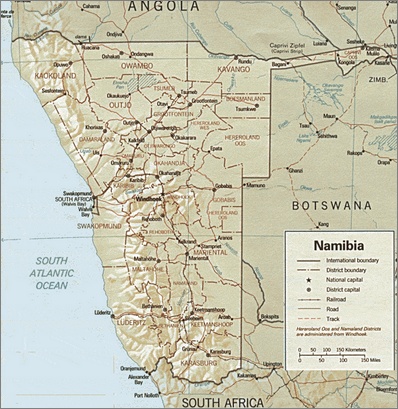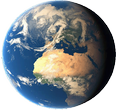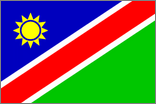






| By far the most famous wildlife park of Namibia, that rivals the Kruger National park in terms of abundancy of animals. The landscape is very arid and the main draw for the animals are the waterholes that are dotted throughout the park. Since most of the activity is found close to these waterholes, it is most rewarding just to park your car at one of these pools and observe the animals coming to drink, interact, play etc. At several of the waterholes, you're likey to see giraf, elephants, zebra, springbok, kudu, wildebeest and with luck lions and rhino. Our most rewarding waterhole was 'kalkheuvel'. Of special interest are the miniscule Kirk's dik-diks, miniscule antilopes, that are found in thick bushes in the south eastern part of the park. Furthermore, the impalas in etosha have a black stripe on their faces, that sepearates them as a subspecies from impalas found in the rest of Africa. Birdlife is also very prolific with over 300 species. A major drawof this park are definately the waterholes at the 3 major rest camps in the park. These places are lit during the night and as such it allows one to oberve nocturnal animal activity around the waterholes. This greatly increases your chances of seeing more shy animals like black rhinos. Especially the waterhole at Okaukuejo is fabulous. |
| One of the star attractions of Namibia is the Namib desert - which de country is named after. It's probably the oldest desert in Afrika and is definately one of the most beautiful in the world. The main gateway to the famous red sanddunes is sesriem which leads into the park ending at the sussusvlei. A truly marvellous place with some trees and greenery in the middle of red sanddunes. Going up dune 45 in the early morning before sunrise is beautifu, but you'll not be the only one, so if you're looking for solitude head straight for the sossusvlei and deadvlei, where you'll have the place for yourself in th early morning. The desert harbours many desert-adapted plants and animals that are found nowhere else. The most wellknown plant in this respect is the Welwitschia mirabilis. It's family of the pine trees, but looks nothing like it: it has a very short stem from with 2 huge leaves grow that allow it to absorb as much moisture as possible in this harsh and dry environment. Presumably they can live up to 2000 years. A great way to see this plant is to take the scenic 'Welwitschia'-drive from Swakopmund. |

| The garden route is kind of misnomer if you ask us. Don't get us wrong; it's a very beautiful stretch of coast a big diversity of towns and nature. However, we haven't seen any gardens... We visited wilderness park and Tsitsikamma NP. Both are very beautiful, great for hiking and birdwatching. Especially Storms river mouth on the east side of Tsitsikamma is very scenic with a very wild coast. |

| The town itself is not of much interest. However, the bay just south of it is a must for birders. This shallow bay is a magnet for migrating and resident wader and other waterassociated birds. Even if you're not into birds the scores of pink flamingos and white pelicans are worth the visit to this bay. |

| This remote most North Western part of Namibia is home to one of the most wel known tribes of Namibia: the Himba. These people still try to cling on to their traditional lives which they have been practising for hundres of years. They are semi-nomadic and live from herding cattle. Since they live in a semidesert area they have adopted a life in which they totally depend on products from their cattle. For instance they never drink water or wash themselves with water, instead they drink milk or blood from cows and rub themselves with butter mixed with red earth, which gives them this red color and smoked herbs to keep clean. Currently, their culture and traditions are under severe pressure as modernity is slowly moving in. Generally though, they seem to be able to combine the best of both worlds: have you ever seen a traditionally clothed himba woman pushing a cart in a modern supermarket? We stayed in a slightly posh lodge (we only camped there) to visit one of the himba villages in the countryside with a local guide. Against our expectations we didn't feel uncomfortable at all, as they also seem to genuinly enjoy our visit, as it may provide them a platform to show how proud they are of their culture. |

 |
 |
 |
 |
 |

| Although part of the same park as the Namib National park, the Naukluft mountains are really different from the sandy desert. This mountain range is prime hiking country and harbours many interesting plant and animal species. The strange looking quivertree, huge cactus-like euphorbias, klipspringers, black eagles, rock hyraxes are all likely to be encountered on one of the hikes that have been laid out in the park. |

| This not well known little park bordering botswana is definately worth a visit when you're travelling through the Caprivistrip or Okavango panhandle. It is extremely rich in it's birdlife as it has both savannas, riverine and swamp habitat. Most species you will find in the okavango delta are also present in this park. Mammalwise, this park one of the best places in Southern Africa to see Roan antilope, a handsome but shy and thinly distributed cousin of the Sable Antilope. In addition, Lechwes, elephants, kudus and hippos are present, along with the smaller mammals. |
| Physical activities: eg Walking / Rafting / swimming Nature: eg National Park / Reserve City / Cultural site |
 |
 |
 |
 |
 |
 |
 |
© Bart Everts
 |
 |
 |
 |
 |

| Damaraland is the stretch of arid land just inland of the skeleton coast. It has many interesting things to see and do. First of all there are socalled concessions, big stretches of land that are set aside for sustainable oturism. We stayed at the Palmwag lodge which is litteraly a couple of palms in the middle of a semidesert. Suprisingly enough the concession surrounding the lodge is very rich in wildlife. Hartmanns mountain zebras, oryxes, springboks and giraffes abound. In addition, lions, elephants and even black rhino move in from Etosha NP during certain times of the year. This makes this area one of the few places in Africa where Black rhinos can be found outside national parks. Furthermore, In the southern part of Damaraland there are several places that are of cultural, historical or geological interest. For instance several thousand year old engraving at twyfelfountain are beautiful examples ofthe cultural richness of former native inhabitants. Also several spectacular rock formations and petrified forests are worth a visit when you are in the area. |

| Swakopmund is the center for adrenaline activities, such as quadbiking and sandboarding in the dunes. However, we did not do any of this. Instead we just walked around in town, which has a clear German feel to it and enjoyed the nice seafront and the couple of museums that scattered through town. |










